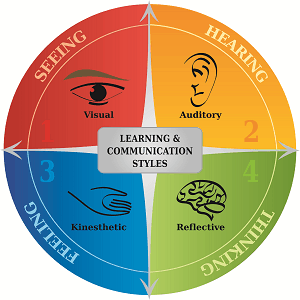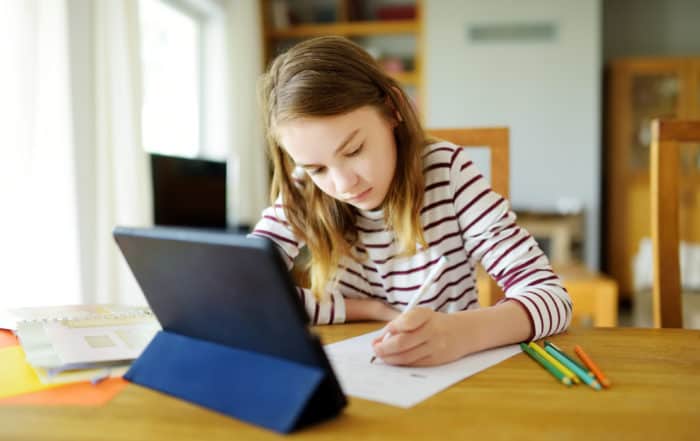 ‘Learning styles’ is a concept which attempts to describe the methods by which people gain information about their environment. People can learn through seeing (visually), hearing (auditorily), and/or through touching or manipulating an object (kinesthetically or ‘hands-on’ learning). For example, looking at a picture book or reading a textbook involves learning through vision; listening to a lecture live or on tape involves learning through hearing; and pressing buttons to determine how to operate a VCR involves learning kinesthetically.
‘Learning styles’ is a concept which attempts to describe the methods by which people gain information about their environment. People can learn through seeing (visually), hearing (auditorily), and/or through touching or manipulating an object (kinesthetically or ‘hands-on’ learning). For example, looking at a picture book or reading a textbook involves learning through vision; listening to a lecture live or on tape involves learning through hearing; and pressing buttons to determine how to operate a VCR involves learning kinesthetically.
Generally, most people learn using two to three learning styles. Interestingly, people can assess their own interests and lifestyle to determine the ways in which they obtain much of their information about their environment. In my case, when I read a book, I can easily understand the text. In contrast, it is difficult for me to listen to an audiotape recording of that book — I just cannot follow the story line. Thus, I am a strong visual learner, and a moderate, possibly poor, auditory learner. As far as kinesthetic learning, I am very good at taking apart objects to learn how an object works, such as a vacuum cleaner or a computer.
One’s learning style may affect how well a person performs in an educational setting, especially from junior high on through college. Schools usually require both auditory learning (i.e., listening to a teacher) and visual learning (i.e., reading a textbook). If one is poor at one of these two ways of learning sources, he/she will likely depend mostly on his/her strength (e.g., a visual learner may study the textbook rather than rely on the lecture content). Using this logic, if one is poor at both visual and auditory learning, he/she may have difficulty in school. Furthermore, one’s learning style may be associated with one’s occupation. For example, those individuals who are kinesthetic learners may tend to have occupations involving their hands, such as shelf stockers, mechanics, surgeons, or sculptors. Visual learners may tend to have occupations which involve processing visual information, such as data processors, artists, architects, or manufacturing part sorters. Moreover, auditory learners may tend to have jobs which involve processing auditory information, such as sales people, judges, musicians, 9-1-1 operators, and waiters/waitresses.
Based on my experience as well as those of my colleagues, it appears that autistic individuals are more likely to rely on only one style of learning. By observing the person, one may be able to determine his/her primary style of learning. For example, if an autistic child enjoys looking at books (e.g., picture books), watching television (with or without sound), and tends to look carefully at people and objects, then he/she may be a visual learner. If an autistic child talks excessively, enjoys people talking to him/her, and prefers listening to the radio or music, then he/she may be an auditory learner. And if an autistic child is constantly taking things apart, opening and closing drawers, and pushing buttons, this may indicate that the child is a kinesthetic or ‘hands-on’ learner.
Once a person’s learning style is determined, then relying on this modality to teach can greatly increase the likelihood that the person will learn. If one is not sure which learning style a child has or is teaching to a group with different learning styles, then the best way to teach could be to use all three styles together. For example, when teaching the concept ‘jello,’ one can display a package and bowl of jello (visual); describe its features such as its color, texture, and use (auditory); and then let the person touch and taste it (kinesthetic).
One common problem evidenced by autistic children is running around the classroom and not listening to the teacher. This child may not be an auditory learner; and thus, he/she is not attending to the teacher’s words. If the child is a kinesthetic learner, the teacher may choose to place his/her hands on the child’s shoulders and then guide the student back to his/her chair, or go to the chair and move it towards the student. If the child learns visually, the teacher may need to show the child his/her chair or hand them a picture of the chair and gesture for the child to sit down.
Teaching to the learning style of the student may make an impact on whether or not the child can attend to and process the information which is presented. This, in turn, can affect the child’s performance in school as well as his/her behavior. Therefore, it is important that educators assess for learning style as soon as an autistic child enters the school system and that they adapt their teaching styles in rapport with the strengths of the student. This will ensure that the autistic child has the greatest chance for success in school.
“School distress” rates are elevated among those with autism
Rates of “school distress”—or significant emotional distress related to attending school—are significantly elevated in children with autism spectrum disorders (ASD), according to a new study from the United Kingdom. Sophie Connolly
“School distress” rates are elevated among those with autism
Rates of “school distress”—or significant emotional distress related to attending school—are significantly elevated in children with autism spectrum disorders (ASD), according to a new study from the United Kingdom.Sophie Connolly and colleagues
ARI: Advancing our Understanding of Autism
Established in 1967, the Autism Research Institute (ARI) is the world's longest-standing organization dedicated to autism research. For more than half a century, we’ve worked to improve the quality of life for
Study investigates responses to pain in individuals with autism
A new study offers insights into the responses of adults with autism spectrum disorders (ASD) to painful stimuli. Tseela Hoffman and colleagues investigated pain perception in 104 adults, 52 of whom
Maximizing Neurodiversity: Education & Jobs
Scientist and psychiatrist Lawrence Fung, MD, Ph.D., discusses what neurodiversity is and how increased awareness and support benefits not only neurodiverse individuals but the global population as a whole. He outlines the
Preparing for Back-to-School During COVID-19
As students prepare to return to school during the COVID-19 pandemic, you may have questions about how to help your loved ones on the spectrum cope with social distancing,






